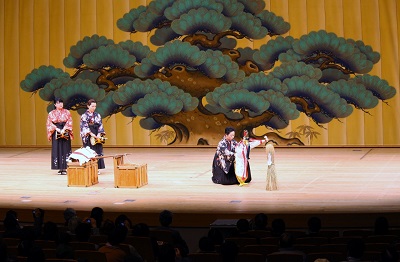受け継いだ阿波木偶「三番叟まわし」
芝原生活文化研究所・阿波木偶箱廻し保存会 お問合せはこちらまで:ebisuあっとme.pikara.ne.jp(あっとを@に変えてお送りください)SANBASOUMAWASHI HAKOMAWASHI
SANBASOUMAWASHI
"SANBASOU MAWASHI"  |
| |
One of the typical New Year celebration
Performances in Shikoku is a puppet show called Sanbasoumawashi. It is said
that it started about 300 years ago. A puppeteer and a tuzumi (hand drum)
player carrying four puppets of Sanbaso(Senzai,Okina,Snbaso) and Ebisu in two
wooden boxes(wicker trunks were used in montinregions) visit houses during the
New Year holidays and perform a puppet show at the gate.
After hanging strips of white paper to Kojin(god), the puppeteer predicts
and celebrates good harvests and a year without disease or disaster using
the four puppets(dekos). In the past, the performers of Sanbasomawashi
visited houses on predetermined dates; consequently, Sanbasomawashi became
a well-established New Year's ritual and custom and was practiced for a
long period of time.
However, most of the performers went out of business. By the late 1960's,
the tradition disappeard from cities and towns and could be found only
in some farm villages in intermediate and mountainous area.
We inherited the SANBASOUMAWASHI.
HAKOMAWASHI
Performing on the roadside: “Hako Mawashi”
|
|
| |
“Hako Mawashi” means puppet theatre
performed as street shows. “Sanbaso Mawashi”, for example, used to be a
ceremony performed at each house for the New Year to pray for good harvests and
a year without disease or disaster. It progressively became the main New Year
ceremony in Shikoku. Dolls of the god Ebisu were also frequently displayed in
fishing communities to pray for a good catch. Puppeteers travelled with their
dolls inside wooden boxes, either alone or as a couple in the case of
husband-and-wife shows: the artists toured the country and performed on street
corners. “Hako Mawashi” puppeteers toured small villages and remote mountain
communities where larger troupes would not go, and made the Awa(Tokushima) and
Awaji style of puppet theatre known throughout Japan’s rural areas. However,
that form of art had almost disappeared by the 1960’s.
芝原生活文化研究所・阿波木偶箱まわし保存会
お問合せはこちらまでebisuあっとme.pikara.ne.jp
(あっとを@に変えてお送りください)
hp開設:2003年
カウンター開始:2005年
Tweet